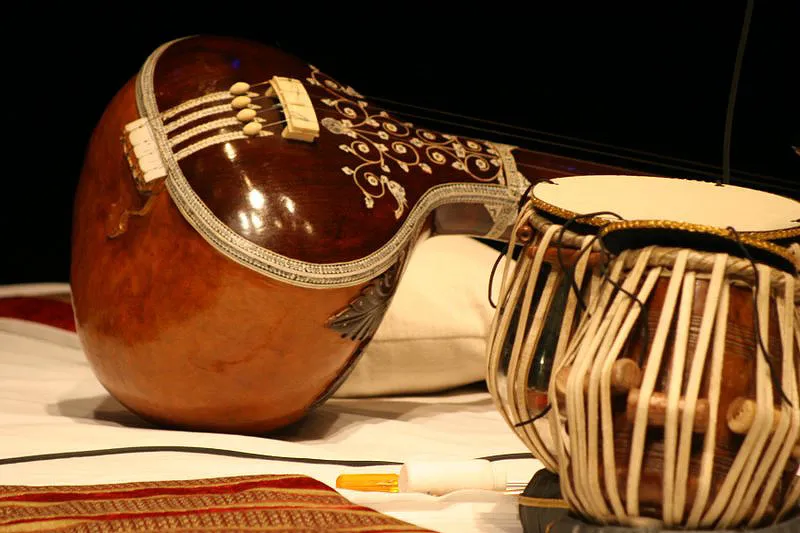Calfskin Instruments, Membranophone or Avanaddha or percussion instruments
Percussion instruments have played a important role in the musical traditions of ancient India, contributing rhythm (taal) to the swara and adding cultural symbolism, and ritualistic significance to various artistic and religious practices. Through references in Vedic texts, classical treatises like Bharata's Natyasastra, and epic narratives such as the Ramayana and Mahabharata, we gain valuable insights into the diverse array of percussion instruments that populated the ancient Indian musical landscape. From the resounding beats of the Muraja to the formidable resonance of the Bheri, each instrument carried its own distinct characteristics, serving as both musical tools and cultural artifacts.
Percussion Instruments in Vedic Literature
The drums covered with the skins of wild animals and large earthen drums reflects the primitive yet essential nature of percussion instruments in ancient times. These drums were a rhythmic accompaniment in Vedic performances. As mentioned earlier, the Rig Veda associates the seven notes with seven meters demonstrating that Vedic musicians had a understanding of music theory and the concept of rhythm and meters.
Membranophone(Avanaddha) refers to instruments that produce sound primarily by way of a vibrating stretched membrane. That merely means these instruments were made by covering a frame of wood or a vessel with a piece of stretched leather that is held in position by thin and long leather straps. The Membranophone instruments are basically the drums and percussion instruments of various sorts. They were used for keeping rhythm, measuring Taala and also for making great sounds.
The percussion instruments, in general, included a large variety of drums varying in their sound-patterns, sound-volume and their purpose. From the loud and noisy thuds of the Pataha to the sweetsounding notes of small drums covered with calfskin, there are many subtle modulations in their sound.
The percussion class of instruments were also categorised, in incredible number of ways, in variety of manners, such as:
- by the rhythm of their beats;
- by the volume , the depth and the pitch of the sound they produce;
- by the materials of which they are made- wood (type of wood) or metal (types of metal) or animal skin (types of skins) ;
- by their size – huge, small or medium; by their shapeeither having two faces or a single face , or as single unit or twin unit;
- by whether they are drum-like, cylindrical or narrowed in the middle like hour-glass ;
- by the manner they are held – either placed on the ground or suspended from the shoulders or held in hands; by whether held / placed vertically or horizontally;
- by the manner in which they are played – struck or rubbed either with stick or hands or both
- Ramayana , at various places, mentions several percussion instruments. The Epic refers to quite a large number of them.
1. Mrudanga - Mrudanga is perhaps the best known and more widely used percussion instrument in all types and forms of Drama, Music or ritual-celebrations. Though it seems the earliest types of Mrudanga were made of clay – as its name suggests (Mrun) , they were later made of wood. And, Mridanga seems to have remained virtually the same over the past several centuries. It is capable of producing rich, varied and complex type of beats. With the dexterous uses of hands and wrists a virtuoso Mridanga can generate successive series of rhythmic sounds. There were 3 types of Mridanga - Ankika, Alingya and Urdhvaka
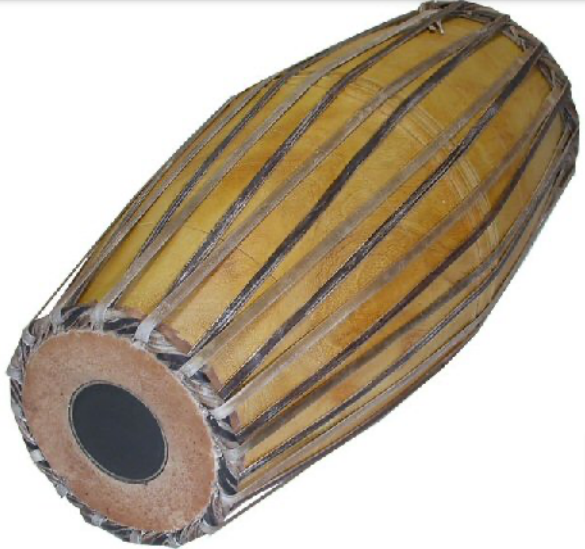
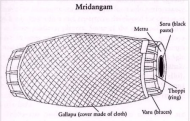
2. Panava - kind of Mridanga with strings were laid from one side to another and which has a hole in the middle. Panava is said to be one of the earliest Avanaddha (covered or percussion) instruments. Paṇava is a small drum. The term Panava is explained as, that which is played with prayers is called Panava. Such prayers sung with the playing of Panava are said to be very dear to Shiva; and, inspire him to dance. Therefore, the Panava was, traditionally, played at the time of worship (Stuti or Deva puja); and, also while giving a battle call.
During ancient times Panava was perhaps a prominent percussion instrument. But, in later times it receded to the background; and , at present is treated as a folk instrument.
Describing the glory and the beauty of Ayodhya, it is said the city resounding with the rhythmic drum beats of Dundubhi, Mrudanga and Panava; with the melodious tunes of string instruments like Veena , the city , indeed, was unique ; and undoubtedly the best city on earth –
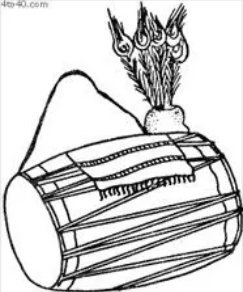

3. Dundubhi (Nagaara) - undubhi which is equated with today’s Nagara is perhaps the most ancient of conical drums; and finds mention in ancient texts. In the early times, it was used both in war and peace. These drums were made of hollow wood covered with hide played during wedding ceremonies as also for welcoming the winning-warriors. The Dundubhi, at times equated with Nagara, is kept also in temples, to be beaten during worship or to announce prayers. The Nagara consists two conical bowl drums struck with sticks. The smaller of the two is higher in pitch; and, the larger has a deeper tone .
Describing the glory and the beauty of Ayodhya, it is said , in Ramayana, the city resounding with the rhythmic drum beats of Dundubhi, Mrudanga and Panava; with the melodious tunes of string instruments like Veena , the city , indeed, was unique ; and undoubtedly the best city on earth
There is also a mention of Bhumi –Dundubhi where the lower part of a huge drum is buried in a pit while the exposed upper part covered with animal hide is beaten with big sized metal or wooden drum-sticks to produce loud booming sounds. This was a special sort of drum and was made by digging a hole on the ground and covering it with a hide. This was employed in the Mahavrata, a rite performed at the winter solstice, for the purpose of driving away the bad influences preventing the return of the sun; bhumi dundubhi is also mentioned in the Samhitas and Brahmanas. The sound of the Bhumi-dundubhi could be heard from a very long distanceThough drums are found in all ancient civilizations from Egypt to Peru, nowhere do we come across earth drums.
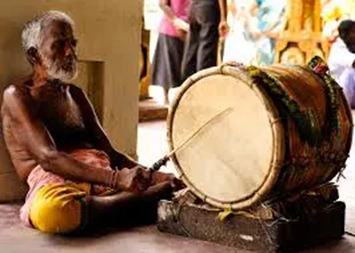

4. Dindima - resembling Damaru but smaller in size. Dindima is a folk instrument, made of hard wood; and, its length is measured as one and a quarter of an arm. It has a face, on each end, is said to be three quarters of an arm, in size. The faces are covered with animal skin. The right face is played with a stick; and, the left with the hands. Dindima is hung from the shoulder to the right side of the player. The sound produced is like Ding –Ding; and hence the name.
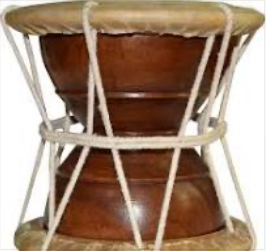
5. Maravala - The smaller drum suspended by a strap from the shoulder and played with a drumstick is probably a Marvala; and, is midway between the more refined Muraja and the noisy Pataha. It must have been very like the modem South Indian Tavil, for each has to be played on one side with a single drumstick, and on the other with the fingers

6. Gargara produces sound like that of a gargara and used in the war.
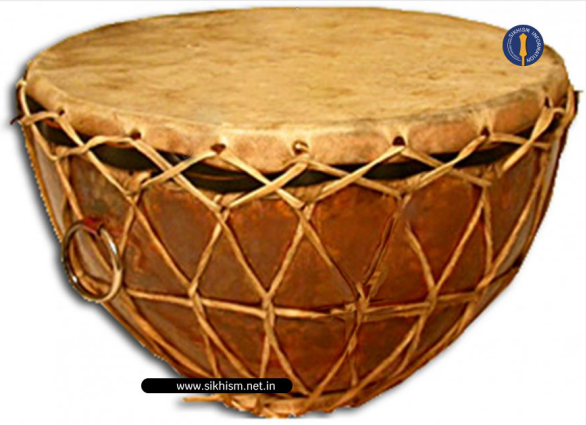
7. Damaru
There is a class of bi-facial avanaddha vadya that are narrow in the middle like the hourglass, sand-glass . These are the Damaru shaped drums. This form has an ancient past and once was a major instrument in sophisticated music. It is closely associated with Lord Shiva when he sports the vigorous Tandava dance. The beats of the Damaru also symbolize the concept of time , in the Indian iconography . But, Today, one hears them only in tribal and folk music not on the concert platform.

The Ramayana refers to other types of drums too -
- Madduka - a big drum of two faces having twelve and thirteen angula- finger lengths
- Muraja - a bifacial drum, the Muraja seems to have had a shape similar to that of the Dindima , having two faces; but, with the heads (beaten surfaces) much smaller and giving out light sounds. Of its two faces, the left one was of eight fingers; and, the right one of seven fingers in width. It was played with hands.
- Adambara was a sort of kettle drum made from udambara tree. The word Adambara, is used by modern day Tamils for pomp and ostentation. Not many people know that it came from the Rig Veda. Tamils say that they celebrated the marriage with Adambara. Actually it was the drum used in such ceremonies. This drum is mentioned in Vajasaneyi samhita
- Bheri - one of the most ancient drums is a two faced metal drum in a conical shape , the leather kept taut by strings; the right face was struck by a Kona and the left one by hand. It produces a roaring sound striking terror in the heart of the enemy. The Bheri, was known for the depth and loudness of its sounds. And, it must have had a very loud and strident tone as the Bheri was meant to stimulate the home-army to a war-frenzy and pierce the heart of the enemies. The Ramayana has a number of references to it. The Ramayana has a number of references to it.
- Pataha - this drum resembled the Dholak of today
Among calfskin instruments Dundubhi and Bhumi-Dundubhi were most significant. Bhagavad Gita begins (Chapters 1 and 12 to 19) with musical instruments that were used on the battle ground! “Conches, kettledrums, tabors, drums and trumpets blared forth and the noise was tumultuous. War music was played when the army marched, which heralded the beginning of the battle. There are musicians and drummers in every army squadron to encourage the soldiers by rousing their military mettle playing on warlike tune and thus spur them on to action. The Ṛgveda-saṃhitā contains verses in a hymn in praise of the war-drum.[1] The Atharvaveda-saṃhitā[2] also contains hymns in praise of the battle-drum, wherein it is described as loud-noised, thundering like a lion, exciting the weapons of the warriors and overpowering hostile plotters. The drum is called Dundubhi, which is an onomatopoeic word, so called on account of the sound it emitted when struck. The word dundubhi is frequently mentioned in the Vedic literature. [3]
Metallic Instruments
After the string instruments (Tata), the hollow instruments (Susira), the covered membranophone instruments (Avanaddha) come the Solid or metallic instruments (the Ghana)
These metallic or solid instruments (Ghana) help to measure time (Kaala) and to maintain the tempo (Laya) . And, those who play the Ghana Vadya-s in a performance should know the rules of Taala and Laya.
The most fundamental of the Ghana (solid) Vadya is said to be the human body itself. It is very common to see clapping of hands (Taala) , counting fingers, waving the hands, striking palms on the thighs or hips, stamping the feet on the dance floor etc in a rhythmic ways to keep or measure time. Even the singers of Sama–Gana kept rhythm by clapping and waving hands. Even today one can see in Northern and Carnatic music concerts, persons (either on stage or in the audience) clapping to keep time (Taala) while percussion instruments are played.
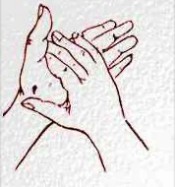
The Ghana vadya-s (Idiophone Instruments) are instruments made of wood or metal that produce sound when they are struck. Along with the solid Cymbals made of metal, Patah and Ghata (bell) are also mentioned as Ghana Vadya-s. The instruments of this group are usually played with a striker or hammer. Cymbals, also called as Taala are but an extension of the act of clapping to keep time.
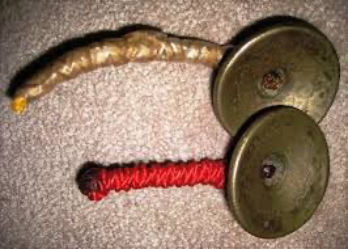
The Ghana vadya-s, made of metal, are not capable of producing definite pitches that are required for creating a melody. That, perhaps, is the reason why they are not used in classical music concerts. But, the Cymbals, the Taala, are an essential part of the Dance music.
And, the Tala (Cymbals) is an essential ingredient of the Bhakthi Samgita and Bhajans.
During a dance or a song on the stage, the Cymbals provide rhythm (Taala) to the flow of music and dance.
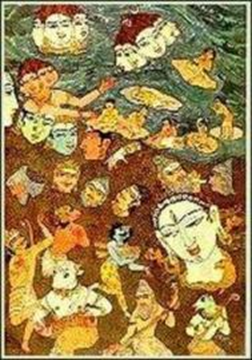
VEDIC ORCHESTRA
During Mahavrata festival and yajna a grand music festival was organised. Agnihotram Ramanujachariar gives the following information: “We have concrete information from the Vedas of prevalence of the orchestral music. A grand music festival with different instruments is associated with the Mahavrata Yaga. In this yaga (fire ceremony) the Udgata is seated in a chair, the Hotha in a swing and the Adhwaryu on a plank. Hotha prays to god while swinging. The wives of the performers of the Yaga sing along with the Udgata with a variety of instruments. The following instruments are mentioned in this connection: A Vana with 100 Strings , Naady (metal pipe), Thunava (wooden flute), Shanka (conch) Kanda Veena, Godha Veenaka ( a small veena covered with the skin of godha) Agati (cymbals), Pichchola, Apa Ghatalathika, Karkarika Ghata karkarika, Shambala veena Ghatari with vandanam (plectrum) Thaluka Veena, Alabu, Kapisharsaki etc. At the same time women standing in a circle with water pots on their heads singing rhythmically, keeping time with their feet. This is like modern Tamil Karakam dance"
References
- sreenivasarao's blogs
- Wisdomlib.org, war music (military music)
- International journal of research, military music used in Vedic warfare
- Origin of Indian Instrumental music
- Swarganga.org (Musical Instruments in India through the ages - by Chaitanya Kunte)
